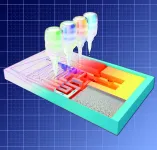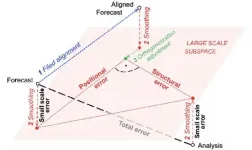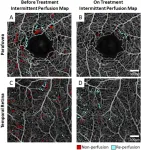One-year results from the FUTURE-II trial
Are bioresorbable scaffolds back in clinical practice?
2021-05-10
(Press-News.org) A decade already passed from the first use of bioresorbable vascular scaffold in percutaneous coronary interventions. The first studies - by using surrogate endpoints - showed some superiority of BRS vs. metallic drug-eluting stent in terms of the so-called vascular restoration therapy with recovery of vasomotion and vascular pulsatility when the scaffold was absorbed.
Nevertheless, after these first promising findings, larger and randomized clinical trials and subsequent meta-analyses, powered to hard clinical endpoints, showed that bioresorbable vascular scaffolds, made of poly-lactic polymer, exhibit a higher rate of target lesion revascularization, with in particular a higher rate of scaffold thrombosis as compared with metallic drug-eluting stent. Interestingly, the implantation technique was related to these events rates, as these first generation bioresorbable scaffolds were characterized by a thick strut (150 micron), which made it similar to first generation metallic DES and therefore very much dependent by a very precise implantation technique.
At light of these findings, BRS made of polylactic acid were withdrawn from the market and only metallic BRS based on a magnesium platform are still used, restricted to a very specific subset of patients included in controlled studies.
Although BRS use is very limited nowadays, the need of a bioresorbable scaffold for treating coronary lesions, leaving nothing behind and allowing the so-called vascular restoration therapy, is still very much alive.
The FUTURE-II trial is a randomized trial comparing a new, thin-strut bioresorbable scaffold - the FIRESORB -poly-L-lactic acid-based sirolimus-eluting vs. everolimus-eluting cobalt-chromium stent (EES). The FIRESORB scaffold may be defined as a second generation bioresorbable scaffold: it is made of poly-lactic polymer, but with a strut thickness of only 100-125 micron, which made it close to second generation drug-eluting metallic stents. The trial wanted to demonstrate non-inferiority of the FIRESORB vs. EES, with a primary surrogate endpoint of late lumen loss at 1-year, which is known to be associated with clinical event rates. Major secondary endpoint is 1-year proportion of covered struts by OCT, which was evaluated in a subgroup of patients.
The trial succeeded to show non-inferiority of FIRESORB vs. EES in terms of 1-year angiographic late lumen loss (0.17 ± 0.27 vs. 0.19 ± 0.37 mm, p for non-inferiority < 0.001). Of note implantation technique was almost perfect in both groups, with a high rate of pre-dilatation and post-dilatation. Non-inferiority was shown also in the secondary OCT endpoints, with a similar proportion of covered struts in both groups; of note a less incomplete strut apposition was found in Firesorb vs. EES group at 1-year, which may be the result of scaffold resorption.
Eventually, no difference was found in terms of target lesion failure between groups with very low rate of events (1.9% vs. 3.3%, p=0.37) and no definite probable device thromboses.
For all these reasons, the results of this trial may revitalize the concept of bioresorbable scaffold or may even stimulate the design of new pivotal studies with this new device. A proper implantation technique together with a device with improved physical and mechanical properties may give the opportunity to have a PLLA-based BRS back in our daily practice in a foreseeable FUTURE.
INFORMATION:
NOTES TO EDITORS
Key information
* A randomised trial of thinner-strut sirolimus-eluting BRS in de novo lesions: one-year results from the FUTURE-II trial - Bo Xu
* Embargo will be lifted on Tuesday 18 May - 9:00 Paris time
* Available on the Video on Demand Section - http://www.europcr.com
* Livestream presentation on 19 May - 11:40 - Coronary Channel
About EuroPCR 2021
The World-Leading Course in interventional cardiovascular medicine and the official annual meeting of the European Association of Percutaneous Cardiovascular Interventions (EAPCI) will take place from 18 to 20 May 2021 online, http://www.europcr.com and in different hubs (depending on the sanitary situation).
The detailed Course Programme is available on: https://www.pcronline.com/Courses/EuroPCR.
About PCR
The mission of PCR is to serve the needs of each individual patient by helping the cardiovascular community to share knowledge, experience and practice. PCR offers a large range of many other educational meetings and resources for the continuing education of the interventional cardiovascular community. These include major annual Courses across the globe, e-Learning with high-profile PCR Webinars, Courses specifically dedicated to valvular heart disease, tailor-made PCR Seminars on specific topics, online resources and medical publications such as EuroIntervention, the official journal of the EAPCI.
Gateways to all PCR activities are available on http://www.pcronline.com.
For further information, please contact Ce?lia Vila?: cvila@europa-group.com.
HELP FOR JOURNALISTS TO COVER EUROPCR 2021
Register and attend EuroPCR 2021 as a journalist
Open to accredited journalists, free of charge. Journalists must hold a valid press card and/or provide a letter of assignment from a recognised publication. To register as press, go to https://www.pcronline.com/Courses/EuroPCR/Press.
EuroPCR press releases can be found at
https://www.pcronline.com/News/PCR-Press-Releases.
For any press-related enquiries, please contact
EuroPCR Press Coordinator, Isabelle Uzielli: iuzielli@europcr.com.
ELSE PRESS RELEASES FROM THIS DATE:
2021-05-10
Researchers at KU Leuven (Belgium) have developed a 3D printing technique that extends the possibilities of lateral flow testing. These tests are widespread in the form of the classic pregnancy test and the COVID-19 self-tests. With the new printing technique, advanced diagnostic tests can be produced that are quick, cheap, and easy to use.
The COVID-19 pandemic has made everyone aware of the importance of rapid diagnosis. The sale of self-tests in pharmacies has been permitted in Belgium since the end of March. This self-test is a so-called lateral flow test. Using a ...
2021-05-10
Analysis of The Autopsy, Toxicological, and Psychiatric Reports of Portugal's First Major Forensic Case: Part III
https://doi.org/10.1080/20961790.2021.1898079
Announcing a new article publication for Forensic Sciences Research journal. In this review article the author Ricardo Jorge Dinis-Oliveira of the University Institute of Health Sciences (IUCS)-CESPU, Gandra, Portugal continues a three-part investigation of the "Crime of Flores Street" one of the most famous cases of poisoning which occurred in Portugal in the late 19th century. The case demonstrated the weaknesses of the Portuguese medicolegal system and attests to the importance of toxicological analysis. The first article ...
2021-05-10
Most people who are infected with SARS-CoV-2 develop no or only mild symptoms. However, some patients suffer severe life-threatening cases of COVID-19 and require intensive medical care and a ventilator to help them breathe. Many of these patients eventually succumb to the disease or suffer significant long-term health consequences. To identify and treat these patients at an early stage, a kind of "measuring stick" is needed - predictive biomarkers that can recognize those who are at risk of developing severe COVID-19.
First biomarker to predict severity of disease
A team led by Professor Burkhard Becher at the Institute of Experimental Immunology at the University of Zurich, working with researchers from Tübingen, Toulouse and Nantes, has now discovered such ...
2021-05-10
Due to the chaotic nature of the atmosphere, weather forecasts, even with ever improving numerical weather prediction models, eventually lose all skill. Meteorologists have a strong desire to better understand this process as they try to trace forecast error back to observational gaps and to provide a means for improvement.
Root mean square error (rms, or its square, the variance distance) is often used to measure differences between simulated and observed fields. In this case, scientists measured the distance between a model forecast field within its grid and the verifying analysis field ...
2021-05-10
A pioneering study by UCL scientists has discovered the presence of a harmful inflammatory protein in patients with symptomatic tuberculosis (TB).
Researchers say, by targeting the IL-17 cytokine, a component produced naturally by the immune system in response to infection, excessive and damaging lung inflammation caused by TB may be significantly reduced to help speed up patient recovery.
TB is an infection caused by the bacterium Mycobacterium tuberculosis and is the leading cause of death from infections worldwide. The World Health Organisation estimates that 1.4 million people died of TB disease worldwide in 2019.
Explaining the experimental study, lead author Dr Gabriele Pollara (UCL Division of Infection & Immunity), ...
2021-05-10
In a time of a global crisis such as the ongoing COVID-19 pandemic, it is easy to note how people move through different phases to buckle up for such unprecedented and arduous times.
In the very beginning of the pandemic last year, we observed "an epidemic of fear", where it was all about the calamitous nature of a totally unknown virus and its worrying contagiousness and mortality rate. A few months later, with lockdown and restrictions already in place across the world, the fear was replaced by "an epidemic of explanations", where people even in their naivety, started to seek a sense of comfort by ...
2021-05-10
Climate change, a pandemic or the coordinated activity of neurons in the brain: In all of these examples, a transition takes place at a certain point from the base state to a new state. Researchers at the Technical University of Munich (TUM) have discovered a universal mathematical structure at these so-called tipping points. It creates the basis for a better understanding of the behavior of networked systems.
It is an essential question for scientists in every field: How can we predict and influence changes in a networked system? "In biology, one example is the modelling of coordinated neuron activity," says Christian Kühn, professor of multiscale and stochastic dynamics ...
2021-05-10
Can expert commissions develop solutions for controversial issues that will enjoy broad democratic support? A team of researchers from the Institute for Advanced Sustainability Studies (IASS) has analysed the work of Germany's "Coal Exit Commission" using a set of new criteria. While the authors view positively the Commission's success in reaching a compromise, they criticise its failure to deliver an outcome that promotes the common good, particularly with respect to the high cost of the coal exit and its unambitious contribution towards Germany's climate goals, as well as the lack of public participation.
On 29 April 2021, Germany's Federal Constitutional Court ruled that the provisions of the Climate Protection Act (2019) are incompatible ...
2021-05-10
Only one in three fertilizations leads to a successful pregnancy. Many embryos fail to progress beyond early development. Cell biologists at the Max Planck Institute (MPI) for Biophysical Chemistry in Göttingen (Germany), together with researchers at the Institute of Farm Animal Genetics in Mariensee and other international colleagues, have now developed a new model system for studying early embryonic development. With the help of this system, they discovered that errors often occur when the genetic material from each parent combines immediately after fertilization. This is due to a remarkably inefficient process.
Human somatic cells typically have 46 chromosomes, which together carry ...
2021-05-10
Ophthalmologists at New York Eye and Ear Infirmary of Mount Sinai have created a new technique to evaluate patients with sickle cell retinopathy and assess the disease before it progresses and leads to permanent vision loss.
Using optical coherence tomography (OCT) angiography--an advanced imaging system that captures the motion of red blood cells in blood vessels non-invasively--the researchers discovered that sequential imaging of affected retinal blood flow in sickle cell patients can help assess how the disease is progressing and how effective their treatment is for reducing focal vascular strokes. Their study was published ...
LAST 30 PRESS RELEASES:
[Press-News.org] One-year results from the FUTURE-II trial
Are bioresorbable scaffolds back in clinical practice?




